SAPPHIRE
ENGAGEMENT RINGS
Your guide to buying a sapphire ring
Ringspo is reader supported
Ringspo is reader-supported, which means we may receive a commission if you click a link to a retailer & subsequently make a purchase.
We feature links to several retailers to help readers find the one that is the best fit for them. Find out more about how Ringspo works here.
Sapphire engagement rings make a great alternative to a diamond ring if you’re looking for something a little bit less predictable. And after Prince William gave one to Kate, they’re increasingly fashionable and popular too.
On this page I’m going to talk to you about everything that you really need to know to get a great sapphire engagement ring, as well as what to look out for to make sure that you don’t get the wool pulled over your eyes.
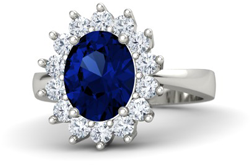
What are sapphires?
For the geology nerds amongst you, Sapphires are actually a form of a mineral called ‘corundum’, and are actually the same stone as rubies. All red corundum is called ruby, while other colors are called sapphires.

Because sapphires are more common than rubies, they are less expensive and more popular. That’s not to say they’re cheap though! A top quality sapphire can easily be more expensive than an equivalently sized diamond.
Sapphires are found all over the world, with major deposits in Myanmar (formerly Burma), Eastern Australia, Thailand, Sri Lanka, East Africa, and even in Montana.
Although you might usually think of sapphires as blue, they actually come in a whole heap of colours, and including yellow, green and purple. Different colours are valued differently, and top quality pink or Padparadscha (a salmon-orange colour) can be more expensive than a top quality blue sapphire.

However, on this page, I’m gong to concentrate mainly on blue sapphires, as these are the most common.
Do sapphires make good engagement rings?
In short, yes.
As well as looking beautiful, sapphires make great engagement rings because they’re pretty durable, which means that they should hold up to the day to day use and abuse that a ring will be subject to.
Every day wear and wear can take its toll on a ring and if the centre stone isn’t hard enough to handle it, it can become chipped and need to be repaired or even replaced.
Thankfully, sapphires score a 9 out of 10 on the Moh’s scale of hardness, which is the scale used to determine the hardness of all natural materials. Coming in at a 9 on the scale puts sapphires just below diamonds, the hardest naturally-occuring material out there. So, although they do need to be looked after a little bit more than diamonds, sapphires are sturdy enough to be used as a centre stone on an engagement ring.
Sapphire buying guide
When you buy an engagement ring, you need to look at it as two separate parts – the center stone itself and then the ring band and setting.
In this section we’re going to look at how to pick a fantastic sapphire center stone – what to look for and what to watch out for. In the next section we’ll then look at a selection of settings for sapphires and at the end you can click through and find the ring that is right for you.
Sapphires, like all other precious stones are judged on their size and quality using the ‘4 Cs’, which you might be familiar with. These are:
- Color
- Cut
- Clarity
- Carat
Unlike diamonds, the ranking for some of these scales is actually pretty subjective, so in this post we’ll look at each of the factors in turn and I’ll let you know what to look for, and what to watch out for, when you’re looking for a sapphire engagement ring.
Sapphire color
Color is the biggest factor that determines the ‘quality’ and therefore value of a sapphire. Sapphires actually come in a wide range of colors, but no matter what color you’re looking at, there are three factors that you need to consider:
Sapphire Hue
Hue is the actual color of the stone – we’re concentrating on blue sapphires in this section.

As well as the main color, most sapphires have a secondary colour also. This could be purple, or green, but lower quality sapphires can also have grey or brown hues that make them appear dull, and are best avoided.
Sapphire Saturation
Saturation is the purity and intensity of the color – with the highest quality sapphires are said to have ‘vivid’ saturation.

Ideally, saturation should be as strong as possible without darkening the color and compromising brightness.
Sapphire tone
Tone is the degree of lightness or darkness of a color, which is relative to the hue and is also affected by the saturation. The best sapphires are medium to medium-dark in tone.
The combination of these factors all contributes to a sapphires overall color, which can range all the way from very light blue to a much deeper black-blue. Mid colored blues are generally thought to be the most desirable, and therefore the most expensive. But sapphire color is subjective, and if you find a light or dark blue sapphire that you love for the right price then go for it.
Below are a few examples of the different blues that you may find, with the names that are commonly use to describe them.


Sapphire origin and color
Sapphires come from many places around the world but only a few locations produce very high quality stones.
Sapphires from Sri Lanka (Ceylon) & Madagascar
Two areas that produce large numbers of very high quality and very similar stones are Sri Lanka (although ‘Ceylon’, the old British colonial name is still often used) and Madagascar.

While production from Magascar has stopped because of political issues, there are still many stones available.
Sapphires from Myanmar / Burma
Myanmar (again, sometimes known as Burma due to the pesky British colonials) produces royal blue sapphires, usually on the darker end of the scale.
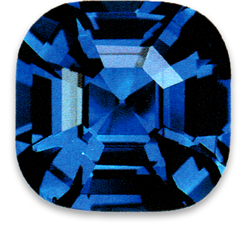
Burmese sapphires are often said to be the highest quality currently being produced and usually command a significant price premium over other stones: 50%-100% more than a stone from Madagascar or Ceylon.
While retailers try and ensure that the country that a certificate says that a stone is from is correct, sometimes it’s very difficult to tell and there’s no guarantee that it is accurate.
You should therefore never pay extra for a sapphire just because you are told that it is from a particular country. Each individual sapphire should be assessed on its own quality and beauty, rather than its place of origin. Concentrate on finding a stone that appeals for you, rather than what is meant to be ‘the best’.
The other sapphire colors, in order of desirability are:
Padparadscha sapphires:
An unusual salmony/orange color, padparadscha is very rare and the most expensive color.

Pink sapphires:
Pink sapphires can sometimes be called rubies, but their color can run anywhere from light pink to a very dark pink known as “hot pink”. Check out Gemvara’s pink sapphire rings here

Purple sapphires:
Squarely in the middle of the pack in terms of desirability and price, they have a wide color range and can look fantastic.

Yellow sapphires:
Usually pretty reasonably priced as they’re found in huge formations. They can look similar to a canary yellow diamond for a fraction of the price. Check out Gemvara’s yellow sapphire rings here

Green sapphires:
The least popular of all sapphires, and priced accordingly, they’re usually a washed out green. But, if you see a green sapphire and you love it, go for it! Gemvara has a range of

Sapphire clarity
Clarity is used to describe the actual quality of any precious stone. With a sapphire, there are two components that you need to look at:
- Inclusions or flaws
- Transparency
Inclusions in sapphires
With diamonds, any visible flaws will make the stone nearly worthless. However, inclusions are an accepted part of buying a sapphire – every stone will have them.

The inclusions are tiny bits of other minerals that are left as the sapphire grows naturally. In fact, if anyone tries to convince you that they have a ‘flawless’ sapphire to sell you then it’s definitely a fake. A flawless sapphire of any notable size is definitely out of your budget, unless your name is Zuckerburg or you’ve just sold your start-up to him.
However, although all sapphires will have inclusions, it doesn’t mean that all inclusions are equal. A good gem-cutter will work with the stone to ensure that they are as minimal as possible and you should be looking for a sapphire that has minimal visible inclusions, or even is ‘eye clean’ ie. the flaws are not easily visible by the naked eye.
The two types of inclusion that you are looking for are:
External: Scratches, nicks or abrasions on the surface of the stone These are considered minor and shouldn’t harm the quality of the stone.
Internal: cracks, chips or cavities within the stone. There are a couple of things to watch out fore with internal flaws
- That they don’t reduce the strength of the stone
- That they don’t block light from passing through the stone, or affect the consistency of its color.
The second point above is important because it can affect the transparency of the stone, which is another mark of its quality. It may be difficult to judge transparency if you’re looking at a stone that is already in a ring setting, but a high quality sapphires should be semi-transparent.
The test that is often used to check the level of transparency is to place a newspaper underneath it – you should be able to just read the words through the stone. So, if you’re looking at a sapphire in a jeweler, pop some reading material underneath it and see if you can make out the text as you look through it.
Treatments and enhancements in sapphires
Although every sapphire will have inclusions to some degree, jewellers do have some techniques to minimise them, in an effort to increase the rock’s value. Some of these treatments are an accepted part of buying a sapphire and won’t affect the value of it too much. However, some are less stable and wear off quickly – they’re just applied to raise the price but will won’t last long.
When you buy a sapphire engagement ring, it’s essential that you know what treatments were applied to the stone and make sure that this is recorded on the certification, as it will have a large impact on what the stone is worth.
Heat Treatment in sapphires
- Pretty much every sapphire that you look at will have been heat treated – it’s viewed as a continuation of the natural heating process that formed the sapphire in the first place
- The treatment involves heating the stone to close to melting point, which causes the inclusions to dissipate and will deepen lighter colors.
- Heat treatments will be labelled as E or H on the sapphire’s certification.
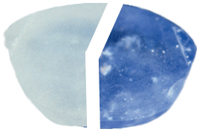
Diffusion treatments in sapphires:
- Diffusion involves applying harsh chemicals to the surface of the sapphire and then heating it to change the color.
- It can change a common and undesirable brown colored rock into a very desirable padparadscha
- Any change is only skin deep – if the sapphire is damaged at all and needs to be repolished or recut, the original color will be visible again.
- Diffusion-treated stones should have U marked on their certificate and are worth much less than those that have not received this treatment
Irradiation treatments in sapphires:
- Another way to change the color of a sapphire and make it more desirable is to expose it to beryllium – a rare chemical element
- It’s difficult to test for irradtiation, but the effects wear off quickly when the stone is exposed to sunlight and the sapphire will return to its original color.
- Irradiated sapphires should be labelled R on their certification and I’d recommend that you avoid them for your engagement ring.
Sapphire ‘cut’ and shapes
Sapphires can be found in any of the major gemstone cuts, but currently the most popular shapes are round, emerald and oval. A round cut is a favourite for any stone, but is often the most expensive.
Trimming all of the corners off a stone to make it into a circle means that a lot of the sapphire hits the cutting room floor, so to end up with a decent sized finished rock, you need a much larger rough stone to begin with.

The emerald and oval cuts minimise the wastage and amount of stone that is lost during the cutting process, which means that they are often used for larger stones.
Vintage sapphire rings can sometimes be shaped into the ‘cabochan’ cut – a basic dome.

Compared to more modern and more intricate cuts, it’s pretty simple, so was easily achieved with the tools that they had available at the time. However, because less workmanship is involved in their production, a cabochon cut sapphire is usually worth less than one with a more complicated shape.
Gem-cutters cut each stone to make the most of that stone’s natural attributes. So, they will cut it to minimise the visibility of any flaws, but they can also use the cut to change the color of a stone. By giving a very dark stone a shallow cut, it will allow more light to pass through, so will lighten and brighten it. Equally, by cutting a very light stone deeper, less light is allowed to pass through, which adds intensity to the color.
Sapphires and ‘carat’
Most gemstones are measured in carats, with one carat being 0.2 grammes. However, smaller sapphires are also measured in millimetres, which definitely makes it easier for me to understand. As a rough guide, a standard size of a round sapphire is 6mm diameter, which is roughly the same size as a 0.75ct diamond.
However, sapphires are actually much denser than diamonds, so a sapphire that is 0.75ct will actually be much smaller than a diamond of the same weight. It’s not worth getting too hung up over the size of an sapphire since there are so many factors that affect how it actually looks – the shape it is cut, the depth it is cut etc.
One thing to watch out for is to ensure that for any sapphire engagement ring you’re looking at, you are quoted the weight of just the centre stone, rather than any supporting stones or even the band itself. This will make if much easier to compare between different rings.
Sapphires and overall ‘quality’ grades
Those are the Four Cs of rubies, but unlike in diamonds which are relatively easy to grade consistently, rubies are much more difficult. Rubies are therefore given an overall grade to make it easier for consumers to understand what they’re getting.
AAA Quality Sapphires
Triple A gemstones are the top 10% of sapphires in terms of quality. They usually have a dark royal blue color and no obvious inclusions. AAA is the highest grade that most jewelers offer.

AA Quality Sapphires
AA are the top 20%-30% of gemstones. They are usually medium blue and very slightly included. They are less suitable for the center stones of rings, but work well as smaller supporting stones.

A Quality Sapphires
‘A’ grade sapphires have a dark blue color, are less translucent and have more obvious inclusions that can be easily seen with the naked eye. The price shold be much lower and I wouldn’t recommend for a large center stone of an engagement ring.

B Quality Sapphires
B stones are darker and more opaque still and have more obvious inclusions. They are more suitable for smaller gemstones in jewelry, like the channel stones in a channel engagement ring setting

Sapphires and certification
A gemstone grading report, or ‘certification’, is a piece of paper to say that the stone has been examined and graded, usually by an independent authority. For those buying a diamond, it’s an essential part of the purchase: it lets them know that what they are buying is the quality that they are paying for.

Ideally it’s an independent lab like Gemological Institute of America (GIA) or American Gem Trade Association (AGTA) that you should be looking for. However, with some retailers you may need to accept the grade that has been given to a stone by the retailer themselves, following an assessment by their in-house gemologists.
As well as listing the size, shape, color and transparency of a stone, a grading report should also list any treatments that have been applied to the stone. One thing that a grading report doesn’t include is a value – that is dependent on the market conditions at the time. A similar report that is conducted to ascertain the value of a stone or of an engagement ring is known as an ‘appraisal’, which are often conducted for insurance purposes.
Sapphire engagement ring settings
The setting is pretty much the most important part of buying an engagement ring – it’s basically what the ring looks like and how it sits on the band. Something to note is that sapphires look better when they’re paired with white coloured metals, rather than gold. Think platinum or white gold. White metals allow the stone to shine with its natural colour, while a gold setting can reflect on the stone and give it a yellow sheen.
Although sapphires are a 9 on the Moh’s scale, they can still be damaged if they are knocked about too much. I’d therefore recommend going with a setting that doesn’t put the sapphire up high and leave it unprotected.
A good way to do this is to go for a halo setting, which puts a ring of other stones around the sapphire which act like the secret service around Obama. Taking this a step further, you could go for a bezel setting, which puts a rim of metal around the rim of the stone, giving it an extra layer of protection – think of it as the armour-plated Cadillac.
Starting with the a classic emerald-cut sapphire in a four-prong solitaire setting, this ring allows the center stone to be shown off with no distractions.
It’s important that a setting like this covers the fragile corners, and extending out to the sides and above the center stone offer it a measure of protection.
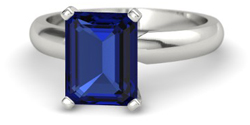

The oval cut is another popular cut for sapphires. It allows for excellent ‘spread’ i.e. the stone has as large a surface area as possible, which makes it looks larger for a particular carat size.
Adding pavé diamonds to the band of a ring is a great way to combine the sparkle of diamonds with the class of a sapphire center stone.
This ring has diamonds set into the band, but also into the sides of the basket, to ensure that it will sparkle brilliantly from any angle. Click to see more details.


The marquise is an less common shape, but its shape means that it maximizes the visible size of the stone for a given carat weight. It also has a flattering elongation effect on fingers and it makes for a very individual choice.
An excellent way to support a center stone and to make a ring more impressive is to add a halo to it. As well as adding some size to the ring and a large amount of sparkle, a halo setting can also give an sapphire engagement ring a measure of protection, as it shields the center stone from knocks.


This oval variation on the halo sapphire engagement ring contains a whopping 44 diamonds for a total diamond carat weight of 0.35 carats, in addition to the large center sapphire.
Oval sapphire ring with diamond halo
Check out the rest of Blue Nile’s selection of gemstone engagement rings
Created to pay homage to the ring that Prince William gave Princess Kate, and which formerly belonged to his mother Diana Princess of Wales, this halo sapphire ring contains 12 larger diamonds in the halo which are larger than the usual size of halo stones. As a result, the ring includes a total of 0.7 carats of diamonds in addition to the center stone to make a truly stunning ring.
Oval Sapphire and Floral Halo Engagement Ring
Check out the rest of Blue Nile’s selection of gemstone engagement rings
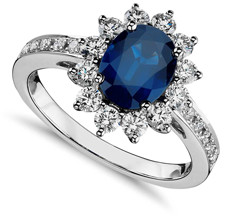

A twist on the Royal tribute ring is this pear-shaped sapphire variation. Like the marquise, the pear is a very flattering cut – the point is traditionally worn towards the end of the finger, which gives a lengthening effect.
Three stone rings are also known as ‘Past, Present and Future’ rings, as the three stones signify the three stages of your relationship. This refined features an emerald cut sapphire flanked by two emerald cut diamonds, which have a combined diamond weight of over half a carat.
Emerald cut sapphire engagement ring with diamond side stones
Check out the rest of Blue Nile’s selection of gemstone engagement rings
Harking back to a bygone era when men wore tartan skirts, painted their faces blue and shouted about ‘freeeedoooooom’ a lot, this antique-inspired sapphire marquise engagement ring is brimming with celtic charm.
Celtic marquise sapphire engagement ring
This intricate vintage-inspired design evokes the decorative scrollwork and lacing of the Edwardian Era.
Bonus point: it’s named the ‘Arya’, after everyone’s favourite surviving (for the moment!) Stark child.

Adding side stones to a ring can be a good way to make sure that the center stone doesn’t need to do all of the impressing on its own. Adding smaller side stones can be a good way of upping the carat count of a ring, without the increase in price that a big increase in the center stone would cost. Diamond side stones are a great way to complement a center sapphire.
Oval sapphire engagement ring with diamond side stones
Check out the rest of Blue Nile’s selection of gemstone engagement rings
